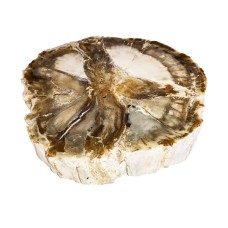Fossils
Crystal fossils, also known as fossilized crystals or mineralized fossils, are fossils in which the original organic material has been replaced or encased by minerals, often forming beautiful and intricate crystal structures. This process can result in fossils that are not only scientifically valuable but also aesthetically appealing. Here are the key aspects of crystal fossils:
Formation of Crystal Fossils
Mineral Replacement: This occurs when minerals carried by groundwater infiltrate the remains of an organism and replace the organic materials cell by cell, preserving the original structure in a new mineral form. Common minerals involved include quartz, calcite, pyrite, and silica.
- Silicification: The replacement of organic material with silica (quartz). This process can produce detailed and durable fossils, commonly seen in petrified wood.
- Calcification: The replacement with calcium carbonate (calcite), often seen in marine fossils like shells and corals.
- Pyritization: The replacement with pyrite (iron sulfide), which can create fossils with a metallic sheen, sometimes referred to as "fool's gold" fossils.
Encrustation: Sometimes, crystals form around or within the spaces of an organism's remains without fully replacing them. This can result in fossils that retain some of the original organic material while being adorned with crystals.
- Geode Formation: In some cases, organisms like shells or bones become the nucleus for geode formation, where crystals grow inside cavities, creating stunning crystalline interiors.
Types of Crystal Fossils
- Petrified Wood: One of the most common and well-known types of crystal fossils. Silica-rich groundwater percolates through buried wood, replacing the organic material with quartz while preserving the original structure of the wood.
- Ammonite Fossils: These marine cephalopods can undergo mineral replacement, often with calcite or pyrite, resulting in beautifully preserved fossils. In some cases, the chambers of ammonite shells can be filled with crystals.
- Dinosaur Bones: Fossilized dinosaur bones can undergo mineralization, with minerals like silica, calcite, or even opal replacing the original bone material, preserving detailed internal structures.
- Shell Fossils: Marine shells can become encrusted or replaced with minerals, resulting in fossils that maintain their original shape but are composed of new, often crystalline, materials.
Characteristics and Appearance
- Color and Luster: The color and shine of crystal fossils depend on the minerals involved in the fossilization process. Quartz may produce clear, milky, or colored fossils, while pyrite gives a metallic gold appearance.
- Detail Preservation: The replacement process can preserve fine details of the original organism, including cellular structures, growth rings, and surface textures.
- Crystalline Structures: In cases where crystals grow within the fossil or encrust it, the resulting structures can range from tiny crystal points to large, well-formed crystals, enhancing the fossil's visual appeal.
Scientific and Aesthetic Value
- Scientific Research: Crystal fossils provide valuable insights into the process of fossilization and the conditions of ancient environments. They help paleontologists study the anatomy, biology, and ecology of extinct organisms.
- Educational Use: These fossils are used in educational settings to teach about mineralization processes, fossilization, and ancient life forms.
-
Fossilised Wood 001
Fossilised Wood –F001 Type: Fossilised wood Dimensions: ≈ Length 10cm x Width 8.5cm x He..
£49.50

